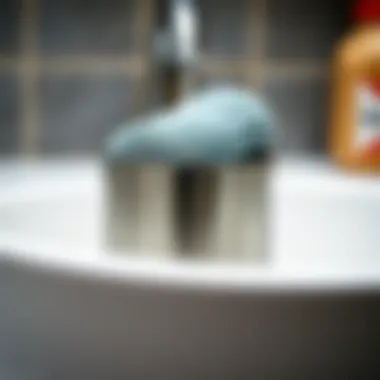Utility and Design of Stainless Steel Sponge Holders


Intro
In the realm of kitchen accessories, stainless steel sponge holders often don’t get the attention they deserve. However, these practical tools can significantly enhance both functionality and aesthetics in cooking spaces. They’re not just a place to stash your sponge; they play a pivotal role in keeping your kitchen organized and hygienic. The combination of sleek designs and robust materials makes them a favorite among homeowners and design professionals alike.
This deep dive explores the multifaceted aspects of stainless steel sponge holders. We’ll navigate through design trends, practical benefits, maintenance tips, and even eco-friendly options available in the market. Understanding these holders goes beyond mere decor; it's intrinsic to the greater conversation about kitchen efficiency and sustainability.
As we delve into this topic, we encourage readers—be they homeowners seeking to modernize their kitchens or designers searching for that perfect accessory—to consider how a simple sponge holder can impact not just aesthetics, but also the very essence of your cooking environment.
"The right kitchen accessory can elevate your cooking experience from mundane to mesmerizing."
Join us as we embark on this insightful journey into the utility and design of stainless steel sponge holders.
Prolusion to Stainless Steel Sponge Holders
In the realm of kitchen organization, small items can have a surprisingly large impact. One such often-overlooked accessory is the sponge holder. Stainless steel sponge holders provide both functionality and style, making them a favored choice among homeowners, designers, and DIY enthusiasts alike. This article dives into their significance, both practical and aesthetic, giving readers a well-rounded understanding of the benefits and considerations involved when integrating such items into kitchen spaces.
The Role of Sponge Holders in Kitchen Organization
A well-organized kitchen isn’t just about having everything in its place; it’s about making tasks simpler and maximizing efficiency. A stainless steel sponge holder does just that. By keeping sponges off counters and away from sinks, these holders help reduce overall mess. Here’s how they contribute:
- Hygiene: Sponges are notorious for harboring bacteria. A holder raises the sponge off surfaces, allowing for better drainage and air circulation. This minimizes the likelihood of odor and bacteria growth.
- Accessibility: Having a designated spot for sponges means they are always at hand, eliminating the need to search through drawers or cabinets when cleaning up.
- Aesthetics: A stainless steel holder can enhance the visual appeal of a kitchen. Whether a modern or industrial theme, this material effortlessly combines function and style.
For a kitchen that stands ready for action while looking tidy, the role of sponge holders cannot be underestimated.
Why Choose Stainless Steel?
When considering materials for kitchen accessories, stainless steel stands out for several compelling reasons:
- Durability: Stainless steel is known for its strength and resistance to wear. Unlike plastic that may crack or chip, stainless steel holders can handle daily use without showing signs of wear and tear.
- Aesthetic Versatility: The sleek, polished look of stainless steel fits seamlessly into various kitchen designs, from ultra-modern to rustic. It can complement appliances and fixtures effectively.
- Hygienic Properties: Stainless steel is non-porous, which makes it less likely to accumulate bacteria compared to other materials. Its surface is easy to clean, promoting better hygiene.
- Eco-Friendly: Metal materials are generally more sustainable than plastics. They can be recycled almost indefinitely without losing quality.
In summary, the choice of stainless steel for sponge holders not only meets functional requirements but also complements the overall kitchen setup. Their qualities make them a sensible investment for anyone who values a stylish yet practical kitchen environment.
Functional Advantages of Stainless Steel Sponge Holders
When it comes to kitchen tools, the selection of materials can greatly impact functionality, safety, and overall aesthetics. Stainless steel sponge holders, in particular, carry a variety of advantages that make them a practical choice for homeowners and designers alike. They go beyond mere aesthetics; they offer qualities that directly contribute to a well-organized and hygienic workspace. Here, we will take a closer look at specific elements such as durability, resistance to bacteria, and the ease of maintenance that make stainless steel sponge holders an appealing option for any kitchen setup.
Durability and Longevity
Stainless steel is renowned for its resilience. Unlike plastic or ceramic counterparts, stainless steel doesn’t crack or break easily. Picture this: you are washing dishes when your sponge holder accidentally falls. While a plastic holder might shatter, a stainless steel one simply endures the slip. This kind of durability signifies that a stainless steel sponge holder can last for years, making it a worthwhile investment. You won’t find yourself needing to constantly buy replacements, which also lightens the load on your wallet.
"Investing in a high-quality material like stainless steel is smarter than frequently replacing lower-quality options."
Additionally, stainless steel withstands heavy use. Whether it’s the constant drip of soap-laden water or daily scrubbing of grimy utensils, this material holds up remarkably well. With proper care, these holders can remain in superb condition for much longer than their less durable alternatives.
Resistance to Bacteria and Odors


One crucial factor in kitchen management is hygiene, and stainless steel shines in this respect. Thanks to its non-porous surface, it doesn’t harbor bacteria or absorb odors the way plastic can. Imagine coming across a sponge holder that smells rancid; it can almost send you running from the sink. In contrast, a stainless steel holder remains inherently resistant to such issues. This characteristic is essential if you want to maintain a clean and fragrant kitchen environment.
Furthermore, stainless steel can be easily sanitized. Regular cleaning with hot, soapy water or a solution of vinegar can help ensure that it remains free from bacteria. Keeping it clean isn’t a chore; it becomes a simple task that can take just minutes. Plus, if you've used it to hold a particularly foul sponge, a quick wash will have it smelling fresh again in no time.
Ease of Cleaning and Maintenance
The maintenance of stainless steel sponge holders is straightforward. With their sleek surface, they rarely retain food particles or grime, making cleaning as easy as a quick rinse. Unlike some textured plastic or ceramic surfaces, which can trap dirt in every crevice, stainless steel allows for effortless wipe-downs. A quick swipe with a cloth can suffice to keep it looking sharp and brand new.
For stubborn stains or spots, a mixture of baking soda and water can be used, transforming your cleaning session into a simple task without harsh chemicals. This ease of care not only saves time but also encourages a regular cleaning schedule that leads to a healthier kitchen atmosphere.
In summary, the functional advantages of stainless steel sponge holders are significant for anyone aiming for an efficient and sanitary kitchen. Their durability represents a smart investment, while their resistance to bacteria and ease of cleaning ensures a dependable and hygienic experience.
Design and Aesthetic Appeal
The design and aesthetic appeal of stainless steel sponge holders plays a vital role in any kitchen. Beyond mere functionality, these holders serve as a bridge between style and practicality, elevating the overall look of your kitchen while ensuring essential tools remain organized. When considering kitchen accessories, it’s crucial to pay attention to their design, as it can influence both your cooking experience and the aesthetic coherence of your space.
Styles and Form Factors
Stainless steel sponge holders come in a variety of styles and form factors, catering to different tastes and kitchen designs. They can range from sleek and modern minimalist designs to more ornate styles that evoke a classic feel. Common shapes include:
- Wall-mounted holders that save counter space and lend a sleek look.
- Caddy-style holders that offer compartments for sponges, brushes, and even dish soap, providing an all-in-one solution.
- Basket designs that allow for water drainage and air circulation, helping keep sponges dry and fresh.
Ultimately, the choice of style should align with your kitchen's overarching theme. A contemporary kitchen may benefit from a linear, unobtrusive sponge holder, while a farmhouse-style kitchen might find charm in a more rustic design.
Matching Holders with Kitchen Decor
To create a cohesive look in your kitchen, consider how your sponge holder complements the decor. Stainless steel offers flexibility because its polished finish can match a variety of materials, including wood, glass, and ceramic. Here are some tips for matching holders with your kitchen decor:
- Color Coordination: While stainless steel is generally neutral, consider its finish—brushed vs. polished. A brushed stainless steel might be ideal for a more muted palette, whereas polished can stand out beautifully against darker colors.
- Material Harmony: If you have wooden cabinetry, look for stainless steel sponge holders that feature wooden accents to tie the design together.
- Thematic Consistency: If your kitchen has a nautical theme, a sponge holder designed like a net or a boat can make it not just functional, but also a conversation starter.
Innovative Features to Consider
When selecting a stainless steel sponge holder, looking for innovative features can further enhance your choice. Some designs come equipped with features like:
- Built-in soap dispensers for added convenience.
- Removable trays for easy cleaning—allowing you to take out residual water or soap easily.
- Anti-slip bases that keep the holder stable, preventing slips on wet surfaces.
Beyond these, consider eco-friendly features, such as using sustainable manufacturing practices or materials, ensuring your choice aligns with a more environmentally-conscious lifestyle.
Sustainability and Material Concerns
In recent years, sustainability has become more than just a trend; it's a necessity we all must consider, especially in our kitchens. The topic of sustainability and material concerns when it comes to sponge holders isn't just about choosing something that looks sleek. It dives deeper into the implications of the materials we select, their origin, and their potential impact on the environment. Stainless steel sponge holders naturally lend themselves to a more sustainable practice in kitchen organization for several reasons.
The Impact of Manufacturing Processes
Manufacturing processes have significant effects on overall sustainability. The production of stainless steel involves mining raw materials and consumes a hefty amount of energy. However, the processes have evolved impressively. Modern methods involve recycling scrap steel, which reduces the demand for mining and minimizes energy consumption. In fact, around 70% of the stainless steel produced comes from recycled materials. This gives it a second life and cuts down on the energy typically required for virgin steel production.
Furthermore, many manufacturers have initiated measures to reduce their carbon footprints during production. They are looking into renewable energy sources and enhancing workplace efficiency. The end result is a product derived from a system that prioritizes both function and environmental responsibility.


"Embracing sustainable materials is about making choices that not only benefit us now but also ensure a better future for the generations to come."
Recyclability of Stainless Steel
Recyclability is a sparkling gem when it comes to stainless steel. Unlike many other materials often found in kitchen accessories, stainless steel can be recycled indefinitely without losing its properties. This means that when you decide to part ways with an old sponge holder, it can be processed and used to create new products.
Here are a few noteworthy points about stainless steel recyclability:
- Closed-loop Recycling: The process is largely a closed-loop, meaning the recycled steel can be transformed back into new products without degradation in quality.
- Energy Savings: Recycling stainless steel consumes roughly 75% less energy than creating new stainless steel from virgin materials, contributing to reduced greenhouse gas emissions.
- Market Demand: There’s a growing market for recycled stainless steel, indicating that consumers and manufacturers are aligning with eco-friendly practices.
So, while shopping for a new sponge holder, think twice about the material. Choosing stainless steel is not just about aesthetics or durability; it embodies a commitment to sustainable living. It aligns with the growing values of an environmentally conscious society and speaks volumes about mindful consumption.
Next time you reach for that sleek stainless steel holder, remember, you're not only investing in durability and style, but also in a sustainable future.
Integration Into Kitchen Workflow
When considering stainless steel sponge holders, it's critical to also evaluate how they fit into the overall kitchen workflow. The efficiency of kitchen operations heavily relies on the strategic arrangement of tools and accessories. Proper integration of these holders into your workspace can contribute significantly to hygiene and efficiency while providing a sleek appearance.
Optimal Placement for Functionality
Finding the right spot for your sponge holder can make all the difference. Ideally, it should be situated near the sink, where the action happens most frequently. However, merely placing it on the counter isn’t always the end of the story. Here are a few considerations for optimal placement:
- Accessibility: The sponge holder should be within arm's reach of the sink. This makes cleaning a breezy task rather than a chore.
- Avoiding Clutter: Choose a spot that doesn’t contribute to countertop clutter. If you have a small kitchen, consider using wall-mounted holders. It frees up your counter space while keeping the sponge handy.
- Consider Water Drainage: A holder with a draining base can avoid the hassle of pooling water. Place it where excess moisture can drip away without damaging surfaces.
In some cases, an under-sink installation could be ideal if you're short on space, but this requires more thought about accessibility. Remember, finding the right placement helps promote cleanliness; a well-placed sponge holder makes it less likely for stains or odors to develop.
Complementing other Kitchen Tools
Another fascinating angle to ponder is how stainless steel sponge holders work alongside other kitchen tools. Think of it like a well-synchronized team. Here are a few ways they can complement your kitchen setup:
- Pairing with Sink Accessories: Stainless holders often blend nicely with other sink accessories like soap dispensers or scrub brushes. Look for cohesive designs and materials to create a unified look.
- Integrating with Cleaning Supplies: Organizing your cleaning supplies more effectively can enhance your workflow. For instance, placing the sponge holder near a coordinating caddy for dish soap can streamline tasks and make cleaning less of a hassle.
- Utilizing Vertical Space: If you opt for a hanging sponge holder, think about how it relates to other vertical space options in your kitchen. Hanging racks can complement wall-mounted pots or utensils, creating an efficient use of space.
"A well-organized kitchen is not merely a convenience; it transforms the act of cooking into a joy rather than a chore."
For further information on efficient kitchen organization, check out useful resources like Wikipedia or Britannica.
Comparative Analysis with Other Materials
The consideration of sponge holder materials speaks volumes about functionality and style. When it comes to designing a kitchen that marries utility with aesthetics, understanding how different materials measure up can greatly influence your choices. While stainless steel sponge holders boast numerous advantages, it's important to weigh these against other options available in the market. The efficacy of the kitchen layout and the overall cleanliness are tightly knit to the type of sponge holder one chooses. As such, exploring alternatives can help consumers make informed decisions that align with their kitchen needs.
Plastic Sponge Holders
Plastic sponge holders might seem like a common choice, mainly due to their affordability and lightweight nature. Often found in vibrant colors and various shapes, these holders can add a splash of personality to your kitchen. However, cost-effective does not always equal the best option. One primary drawback of plastic holders is their susceptibility to wear and tear over time. Exposure to heat and moisture can lead to cracks or discoloration, ultimately requiring replacement sooner than expected.
Moreover, plastic can harbor bacteria and odors. Each time the sponge is placed back in the holder, it might carry with it remnants of food particles or moisture, providing an inviting environment for bacteria growth. Even with regular cleaning, the porous nature of some plastics proves challenging for maintaining hygiene, raising questions about long-term use in health-centric kitchens.
"Choosing sponge holders made from durable materials can significantly enhance your kitchen's cleanliness and maintenance routines."


Another factor is the environmental concern: many types of plastic are not recyclable, meaning they contribute to landfill issues. If you’re aiming for an eco-friendly kitchen, these holders may not align with your goals. Additionally, when stained, plastic holders can lose their aesthetic appeal, potentially clashing with the surrounding decor.
Ceramic and Glass Options
On the other hand, ceramic and glass sponge holders ooze elegance and style, serving as a subtle statement piece in any kitchen setup. They come in diverse designs and can complement various decor styles—from rustic to modern chic. Furthermore, these materials are non-porous, reducing the chances of harboring unwanted bacteria and ensuring a longer-lasting freshness.
However, it's not all sunshine and rainbows with ceramic and glass. They are more fragile compared to plastic or stainless steel, making them susceptible to chips or cracks, especially in a bustling kitchen environment. This fragility may pose a concern in homes with children or high activity flow. Moreover, heavy-duty cleaning products are often advised for maintaining their clarity, adding an extra step to regular maintenance routines.
When it comes to pricing, ceramic and glass options can also fall on the higher end of the spectrum. Investing in a quality ceramic or glass holder might require a more considerable upfront cost than their plastic counterparts. Yet, the blend of visual appeal and hygiene might make this trade-off worthwhile for many homeowners and designers.
Consumer Buying Guide for Sponge Holders
When it comes to outfitting your kitchen with reliable accessories, a sponge holder may not be the first thing that springs to mind. Yet, its role is pivotal in maintaining a tidy and functional workspace. This buying guide focuses on elements that should make their way onto your radar when shopping for a sponge holder.
Key Features to Look For
Choosing the right sponge holder involves more than just picking one off the shelf. Here are some key features to consider:
- Material Quality: Opting for stainless steel not only brings durability but also a sleek look. Consider holders that have a high-grade finish; this minimizes the chances of corrosion or scratches over time.
- Design and Style: Aesthetic appeal matters. Depending on your kitchen decor, you might favor minimalistic or more ornate designs. Make sure the holder complements your overall style rather than clashes with it.
- Size and Capacity: Think about how many sponges and cleaning pads you want to store. Holders in various sizes can better accommodate your specific needs—too small, and it might not hold everything; too large, and it might take up unnecessary space.
- Drainage Features: No one likes a soggy sponge. Look for holders that come with drainage systems to keep your sponge dry and prevent bacteria growth.
- Versatility: Some sponge holders come with extra features, like hooks for dish towels or slots for scrub brushes. This can add extra functionality to a simple accessory, effectively making it a multitasker in your kitchen.
Understanding Price Variability
The market for sponge holders can range significantly in price, and for various reasons. Here's what contributes to this variability:
- Brand Influence: Well-known brands may command higher prices due to perceived quality or design reputation. However, this doesn’t mean lesser-known options aren’t just as effective.
- Material Composition: The type of stainless steel and any additional materials can affect pricing. Higher quality and unique blends typically lead to a higher cost.
- Design Complexity: A plain sponge holder will generally cost less than one featuring intricate designs or multifunctional capabilities. If unique aesthetics are important to you, be prepared to pay a premium for that.
- Market Trends: Changes in consumer demands can impact prices. For instance, a surge in demand for eco-friendly designs could push prices up as brands catch on to trends.
"Investing in a quality sponge holder can be a wise decision—functionality meets design in a tidy, organized kitchen environment."
Ultimately, understanding these elements can guide homeowners, designers, and DIY enthusiasts on their journey toward selecting the sponge holder that’s right for their kitchen and lifestyle. Taking the time to evaluate these factors ensures that you’re not just purchasing a decorative item, but investing in a useful tool that enhances your kitchen experience.
End: Making an Informed Choice
In today’s fast-paced world, it’s easy to overlook the small details that can revolutionize our living space, especially when it comes to kitchen accessories like stainless steel sponge holders. Making an informed choice in selecting one can significantly impact not just the organization of your kitchen but also its overall aesthetic and hygiene.
When considering a sponge holder, several critical elements come into play. Your choice should reflect not only your personal style but also functional benefits. Stainless steel stands out for its durability and longevity, which means you won't find yourself replacing it every few months. Additionally, its resistance to bacteria and odors ensures a clean environment for food prep, making it a wise choice for health-conscious homeowners or aspiring chefs.
Moreover, the ease of cleaning is particularly valuable in a busy kitchen. A good sponge holder won’t trap scum or grime; instead, it will make sure that your sponge is dry and ready to go. This minor investment often leads to significant time savings down the road.
Summarizing the Benefits
The selection of a stainless steel sponge holder comes with a bouquet of benefits that caters to both functional needs and aesthetic desires:
- Durability: It can withstand the test of time without rusting or deteriorating.
- Hygiene: Stainless steel minimizes bacteria growth and foul smells, maintaining cleanliness.
- Style: Available in various designs, ensuring it complements your kitchen decor.
- Easy to Clean: Unlike plastic, these holders can be easily wiped down or thrown in the dishwasher.
- Sustainability: Many stainless steel options are made from recycled materials and are recyclable themselves, making them a more eco-friendly choice compared to plastic alternatives.
"A small choice can lead to substantial changes in the kitchen lifestyle, combining functionality with design seamlessly."
Future Trends in Kitchen Accessories
As we look ahead, the market for kitchen accessories, including sponge holders, is evolving with trends toward minimalism and multifunctionality. This means not just a focus on what works, but also how well it fits into a broader design ethos.
Expect to see:
- Smart Materials: With technology advancing, some sponge holders may feature integrated drying methods or antimicrobial coatings that keep the sponge cleaner for longer.
- Sleek Designs: Homes are increasingly leaning towards minimalistic aesthetics. Expect to see streamlined, unobtrusive designs that blend seamlessly with countertops.
- Customization Options: Personalized products are trending, allowing users to select finishes and styles that suit their tastes and kitchen themes.
- Eco-Friendly Innovations: The push for sustainability will likely bring more options made from recycled or sustainable resources, appealing to environmentally conscious consumers.















